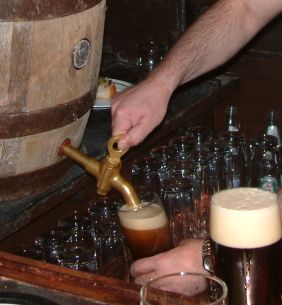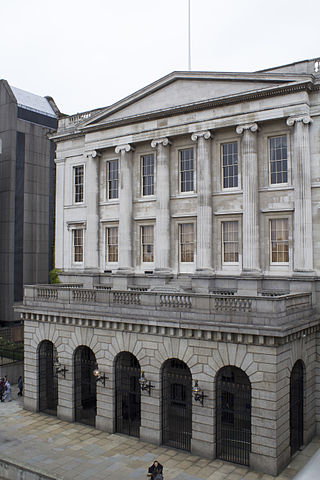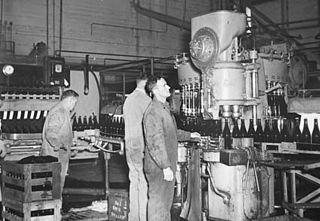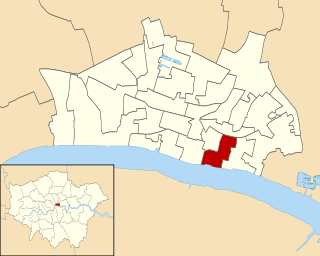Related Research Articles

Beer is an alcoholic beverage produced by the brewing and fermentation of starches from cereal grain—most commonly malted barley, although wheat, maize (corn), rice, and oats are also used. The grain is mashed to convert starch in the grain to sugars, which dissolve in water to form wort. Fermentation of the wort by yeast produces ethanol and carbonation in the beer. Beer is one of the oldest alcoholic drinks in the world, the most widely consumed, and the third most popular drink after water and tea. Most modern beer is brewed with hops, which add bitterness and other flavours and act as a natural preservative and stabilising agent. Other flavouring agents, such as gruit, herbs, or fruits, may be included or used instead of hops. In commercial brewing, natural carbonation is often replaced with forced carbonation.

A pub is in several countries a drinking establishment licensed to serve alcoholic drinks for consumption on the premises. The term first appeared in England in the late 17th century, to differentiate private houses from those open to the public as alehouses, taverns and inns. Today, there is no strict definition, but the Campaign for Real Ale (CAMRA) states a pub has four characteristics:
- is open to the public without membership or residency
- serves draught beer or cider without requiring food be consumed
- has at least one indoor area not laid out for meals
- allows drinks to be bought at a bar

Southwark is a district of Central London situated on the south bank of the River Thames, forming the north-western part of the wider modern London Borough of Southwark. The district, which is the oldest part of South London, developed due to its position at the southern end of the early versions of London Bridge, for centuries the only dry crossing on the river. Around 43 AD, engineers of the Roman Empire found the geographic features of the south bank here suitable for the placement and construction of the first bridge.

Pale ale is a golden to amber coloured beer style brewed with pale malt. The term first appeared in England around 1703 for beers made from malts dried with high-carbon coke, which resulted in a lighter colour than other beers popular at that time. Different brewing practices and hop quantities have resulted in a range of tastes and strengths within the pale ale family. Pale ale is a kind of Ale.

A livery company is a type of guild or professional association that originated in medieval times in London, England. Livery companies comprise London's ancient and modern trade associations and guilds, almost all of which are styled the "Worshipful Company of" their respective craft, trade or profession. There are 111 livery companies in total. They play a significant part in the life of the City of London, not least by providing charitable-giving and networking opportunities. Liverymen retain voting rights for the senior civic offices, such as the Lord Mayor, Sheriffs and Common Council of the City Corporation, London's ancient municipal authority with extensive local government powers.

Wingrave is a village in Buckinghamshire, England, about four miles northeast of Aylesbury and three miles southwest of Wing.
Conner or Conners may refer to:
The court leet was a historical court baron of England and Wales and Ireland that exercised the "view of frankpledge" and its attendant police jurisdiction, which was normally restricted to the hundred courts.

Beer has been brewed in England for thousands of years. As a beer brewing country, it is known for top fermented cask beer which finishes maturing in the cellar of the pub rather than at the brewery and is served with only natural carbonation.

Beer arrived in Australia at the beginning of British colonisation. In 2004 Australia was ranked fourth internationally in per capita beer consumption, at around 110 litres per year; although, the nation ranked considerably lower in a World Health Organization report of alcohol consumption per capita of 12.2 litres. Lager is by far the most popular type of beer consumed in Australia.

McMullen's, known locally as Mac's, is a regional brewery founded in 1827 in Hertford, England. The brewery expanded during the second half of the 19th century by purchasing other breweries and their associated pubs.
The Assize of Bread and Ale was a 13th-century law in high medieval England, which regulated the price, weight and quality of the bread and beer manufactured and sold in towns, villages and hamlets. It was the first law in British history to regulate the production and sale of food. At the local level, this resulted in regulatory licensing systems, with arbitrary recurring fees, and fines and punishments for lawbreakers. In rural areas, the statute was enforced by manorial lords, who held tri-weekly court sessions.

Bridge and Bridge Without is a small ward in the City of London and is named from its closeness to London Bridge. Since boundary changes in 2003, Bridge is bounded by the River Thames to the south, Swan Lane and Gracechurch Street to the west, Fenchurch Street to the north, and Rood Lane and Lovat Lane to the east.
The Royal Commission on the Corporation of the City of London was a royal commission, established in 1853, which considered the local government arrangements of the City of London and the surrounding metropolitan area.
The King's Manor - formally 'The City of London's King's Manor of the Town and Borough of Southwark' - is an institution of the City of London which is not a Livery Company as it is territorially rather than trade based, being the organisation of the Juror freemen of the Court Leet. The Manor covers the area from the western-side of Borough High Street, Southwark, to the borders of Newington and Lambeth. The manor originally lay in Surrey.
Bridge Without was a historical ward of the City of London situated to the south of the River Thames, which existed between 1550 and 1899. The area of the Bridge Without ward today forms part of the London Borough of Southwark. It was so-called to distinguish it from the ward of Bridge Within which covered the buildings on London Bridge and the nearby north bank of the Thames. Bridge Within since 1978 is formally called Bridge and Bridge Without.

Beer in Scotland is mostly produced by breweries in the central Lowlands, which also contain the main centres of population. Edinburgh and Alloa in particular became noted for the export of beer around the world in the 19th century.
Guildable Manor is a Court Leet in Southwark under the authority of the City of London, along with the King's Manor, Southwark, and the Great Liberty.
Invercargill Brewery was the southernmost brewer of beer in New Zealand. It was established by Steve Nally in 1999 near Invercargill.
References
- ↑ "Ale-conner". Encyclopaedia Britannica . Vol. 1 (14 ed.). 1930. p. 553.
- ↑ The National Cyclopaedia of Useful Knowledge, Vol I, London, Charles Knight, 1847, p.410.
- ↑ "Appendix - Act of CoCo 2013 (elections in common hall)" (PDF). cityoflondon.gov.uk. 2013. Retrieved 11 April 2023.
- ↑ The Most Unpopular Job in Greenwich
- ↑ Chisholm, Hugh, ed. (1911). . Encyclopædia Britannica . Vol. 1 (11th ed.). Cambridge University Press. p. 538.
- ↑ "The Verbal History of Beer". Goddards Brewery. Retrieved 16 December 2024.
- ↑ "Common Hall 25 June 2018". WCC. 26 June 2018. Retrieved 22 December 2024.
- ↑ "The Officers of the Guildable Manor". The Guildable Manor of Southwark. Retrieved 15 December 2024.